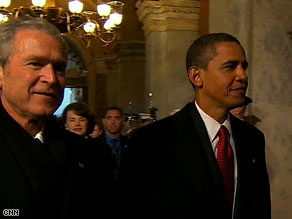Although this story is old news, I thought it appropriate to share here in light of recent posts on bullying, the Day of Silence and the Golden Rule Pledge.
Watch this You Tube video which is a clip from a 2006 episode of 20/20 with John Stossel. More explanation follows:
Zaal and Boger appeared on NPR last November and continue to share their story at the Museum of Tolerance. I encourage you to read the entire piece but here are some highlights:
For nearly three decades, Tim Zaal thought he had killed a man during his rage-filled youth. The idea haunted him, but he buried it with the rest of his skinhead past.
“This used to be my stomping grounds,” says Zaal, standing on a street in West Hollywood, Calif., where he used to hang out in the early ’80s. “Mostly punk rockers would hang out around here after concerts and we would be involved with violence on a regular basis. Violence for me, back in those days, was like breathing.”
Zaal recalls the first meeting with Matthew Boger:
Zaal recalls that particular night, when he thought he took another man’s life. It began with listening to a band called Fear. During the show, a bouncer was stabbed and the police came. By the time he and his friends got to Oakie Dogs, they were juiced up on alcohol and testosterone and spoiling for a fight.
They found their victims across the street, a group of gay street kids. They were just hanging out when Zaal and his friends cornered one and started kicking and hitting him — 14 skinheads pummeling him all at once. But the small gay kid was still moving. For some reason, that enraged Zaal.
“I walked up and said, ‘What is wrong with you guys, can’t you do it right?’ ” Zaal recalls. The kid they were beating on looked up and made eye contact with Zaal. “I kicked him in the forehead with my boot and that was it,” Zaal says, snapping his fingers. “He was out like a light.”
Then they met a second time:
A few years ago, the Museum of Tolerance in Los Angeles asked him to speak about his experience leaving the skinhead movement. Before the talk, he found himself chatting with his fellow presenter, Matthew Boger, the manager of operations.
“I asked Tim how he got out of the skinhead movement and what that was like,” Boger recalls.
The pair reminisced about West Hollywood back in the ’80s.
“And there was this moment in which I said that I lived on the streets,” Boger says, “in which I said I hung out on this hamburger stand, and [Zaal] said, ‘You know, we used to hang out there, but we stopped hanging out there after this one night that was so violent, I think I killed a kid.’ ”
In a flash they both knew without saying that Boger was that kid.
“It was the very first meeting that we had realized who we were to each other 20-something years ago,” Boger says.
Zaal recalls the moment the way anyone in his position would.
“Of course I was ashamed,” he says. “I didn’t know how to handle the situation. And obviously he didn’t how to handle the situation and he left as quickly as possible. It was about two weeks before I saw him again.”
This led to a remarkable picture of forgiveness and reconciliation.
Now Zaal and Boger present their story — and their unlikely friendship — to high school and middle school students around Southern California. They also do a tag-team presentation one Sunday every month at the Museum of Tolerance. It begins with a DVD film of their story and ends with a question and answer session.
Zaal says Boger used to bait him, and test him, to see if maybe those white supremacist ideas he held as a youth were still there, buried, in the grown man. But as time passed, both say that forgiveness — and redemption — have happened.
The two are writing a book about their experiences and were featured in a short documentary called Blood Brothers embedded here:
There are lessons here. I suspect this story is a like a projective test and people will derive lessons based on how they see the world. What can we learn from Mr. Boger and Mr. Zaal?
